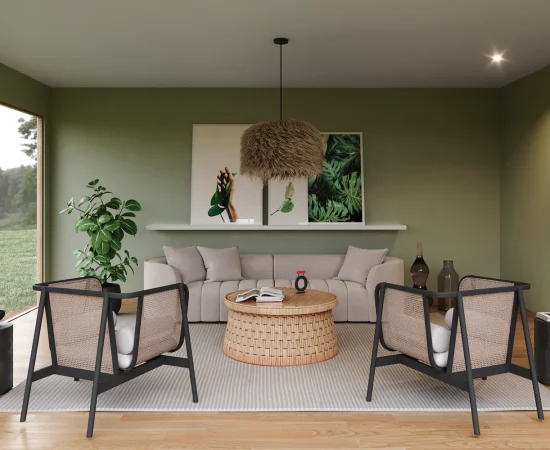Creating a happy and harmonious living environment entails more than just choosing furniture and organizing decorations for home decor. The colors you pick for your house have a big impact on your mood and emotions. In this article, we’ll dig into the fascinating subject of color psychology in home décor, looking at how different hues may affect your living space and give advice on how to choose the right colors for a happy and uplifting environment.
The Effect of Colors on Mood in home decor:
Colors have a strong influence on our emotions and mental health. Understanding the psychological influence of each hue can allow you to make more educated decorating decisions.
- Calm & Tranquil Blues: Blue is noted for its calming and quiet qualities. Ideal for creating a relaxing atmosphere in bedrooms and baths. Lighter tones encourage relaxation, while darker blues provide a sense of steadiness.
- Energetic and Vibrant Reds: Red is connected with vitality, passion, and warmth. It works well as an accent color in situations where social contact is encouraged. Avoid using too much red in bedrooms, since it might be too stimulating for a relaxing setting.
- Soothing Greens to Balance: Green represents nature, balance, and harmony. Suitable for a variety of environments, providing a sensation of freshness and tranquility. Light greens in the kitchen and living room may create an inviting ambiance.
- Yellow is a cheerful color that represents optimism: Yellow symbolizes happiness, enthusiasm, and vitality. Ideal for kitchens and dining spaces, creating a vibrant and hopeful atmosphere. To create a warm and friendly atmosphere in your bedroom, choose softer tones.
- Neutral Tones for Versatility: Neutral hues such as beige, gray, and white make an adaptable backdrop. Ideal for achieving a timeless and beautiful appearance. For a more individualized look, add bursts of color with accessories.
Tips for Selecting the Right Colors:
- Consider the Room Function: Make color selections based on the function of each area. Colors that are soothing for bedrooms, vibrant for social spaces, and balanced for workspaces.
- Natural Light and Room Size: Assess the quantity of natural light in each room. Darker colors may make small spaces seem confined, whereas brighter tones provide a sense of space.
- Personal preferences: Consider your personal tastes and how specific colors make you feel. Incorporate your preferred colors to create an environment that speaks to you.
- Create Cohesion: Maintain a consistent color scheme throughout your property. For a coherent and visually appealing appearance, use different shades of the same hue or complementary colors.
Choosing colors for different rooms:
- Living Room: Warm neutrals, such as beige or light gray, make a pleasant and inviting living room. Use accent colors in furniture or décor to offer individuality without dominating the room.
- Bedroom: Soft blues, greens, and subdued purples can help to create a peaceful bedroom ambiance that promotes restful sleep. Avoid using bright colors in the bedroom since they might make it difficult to rest.
- Kitchen and Dining Areas: To promote hunger in the eating room, choose enticing hues such as warm reds, yellows, and earthy tones. Consider utilizing a variety of colors to create a bright and attractive atmosphere for family dinners.
- Home Office: Blues and greens enhance attention and productivity, making them perfect for home offices. Maintain a bright and energetic work atmosphere by including natural light and using lighter tones.
Practical Tips for Implementing Color Psychology:
- Color Samples Before Committing: Test paint samples or other colored décor pieces before making a final selection. Consider the effects of natural light and room size on color perception.
- Harmonize Colors Across Rooms: Choose a color palette that matches each space in your house to create a seamless flow. Color harmony promotes unity and balance across the living area.
- Personalize with accents: Personalize your space and incorporate accent colors using items like carpets, curtains, and artwork. This offers for the freedom to change color schemes without requiring costly changes.
Conclusion:
Color psychology may help you create a happy and uplifting environment in your house. Understanding the emotional influence of different colors and considering elements like space function, natural light, and personal preferences may help you create an atmosphere that not only looks beautiful but also encourages well-being.
Eco-Friendly Home Decor: Sustainable Choices For A Stylish Space




